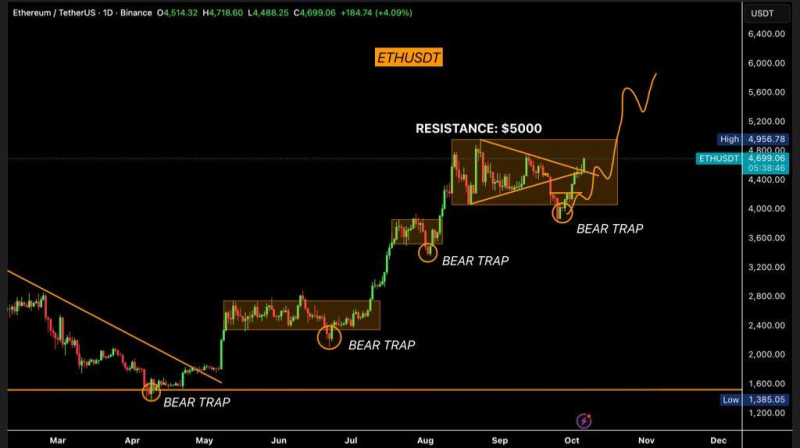Ethereum is making waves again. After shaking out weaker traders through multiple false breakdowns, ETH has staged a convincing breakout that puts the $5,000 level squarely in focus. The chart tells a story of resilience—repeated recoveries from bear traps have built momentum, and if volume holds, there's a clear runway to higher prices.
Current Price Action
As noted by trader Jackson Liam, Ethereum's momentum has been explosive lately. The numbers back this up: ETH is currently trading around $4,699, having reclaimed $4,600 as solid support. If bulls can push through $5,000 with conviction, the next stops could be $5,500 or even $6,000 in the coming weeks.

The ETH/USDT chart shows some telling technical features. That $4,600 level? It's held up well as support. The $5,000 mark remains the big psychological barrier everyone's watching. What's interesting is how ETH has faked out bearish traders at least three times this year—in April, June, and September—each time bouncing back sharply. The breakout from a consolidation triangle adds weight to the bullish case, and volume has been solid on each upward move, suggesting buyers aren't just along for the ride—they're driving.
What's Fueling the Rally
Several factors are converging to support Ethereum's climb. There's growing chatter about a potential ETH ETF, and institutional money seems to be flowing in. On-chain activity remains healthy, with DeFi protocols, NFT platforms, and Layer-2 solutions keeping demand for ETH elevated. Broader market conditions are helping too—a softer dollar and renewed appetite for risk assets have lifted the entire crypto space. And those repeated bear trap recoveries? They've done wonders for trader confidence, encouraging more aggressive positioning on the long side.
What Happens Next
Ethereum is at a crossroads. Break above $5,000 and hold it, and we could see a quick run toward $5,500–$6,000. Fail to defend $4,600, and ETH might slide back into a choppy consolidation phase that delays the next major leg up. The key thing to watch is volume—if it stays strong, the breakout is probably real. If it fades, caution is warranted.
 Usman Salis
Usman Salis

 Usman Salis
Usman Salis


